Dogue de Bordeaux, Bordeaux Mastiff, French Mastiff or Bordeauxdog is a solid gentleman who rarely shows true emotions. Under the mask of feigned importance, there is a good-natured and cheerful fat man who is worth making friends with!
The Dogue de Bordeaux seems like an unsociable giant, but deep down he is not averse to showing affection and soaking up the arms of its owner. Strong affection for family members often takes a serious turn: if a huge dog decided that now is the right time for “kissing”, then it will not work to leave dry after meeting with a loving pet. However, such strong sociability should hardly be considered a disadvantage, because this is a kind of “key” with which the dog will open the door to the heart of the future owner! So feel free to make acquaintance with the Dogue de Bordeaux if you dream of a devoted friend who will give you love and attention. A personable companion instills confidence and a sense of security.
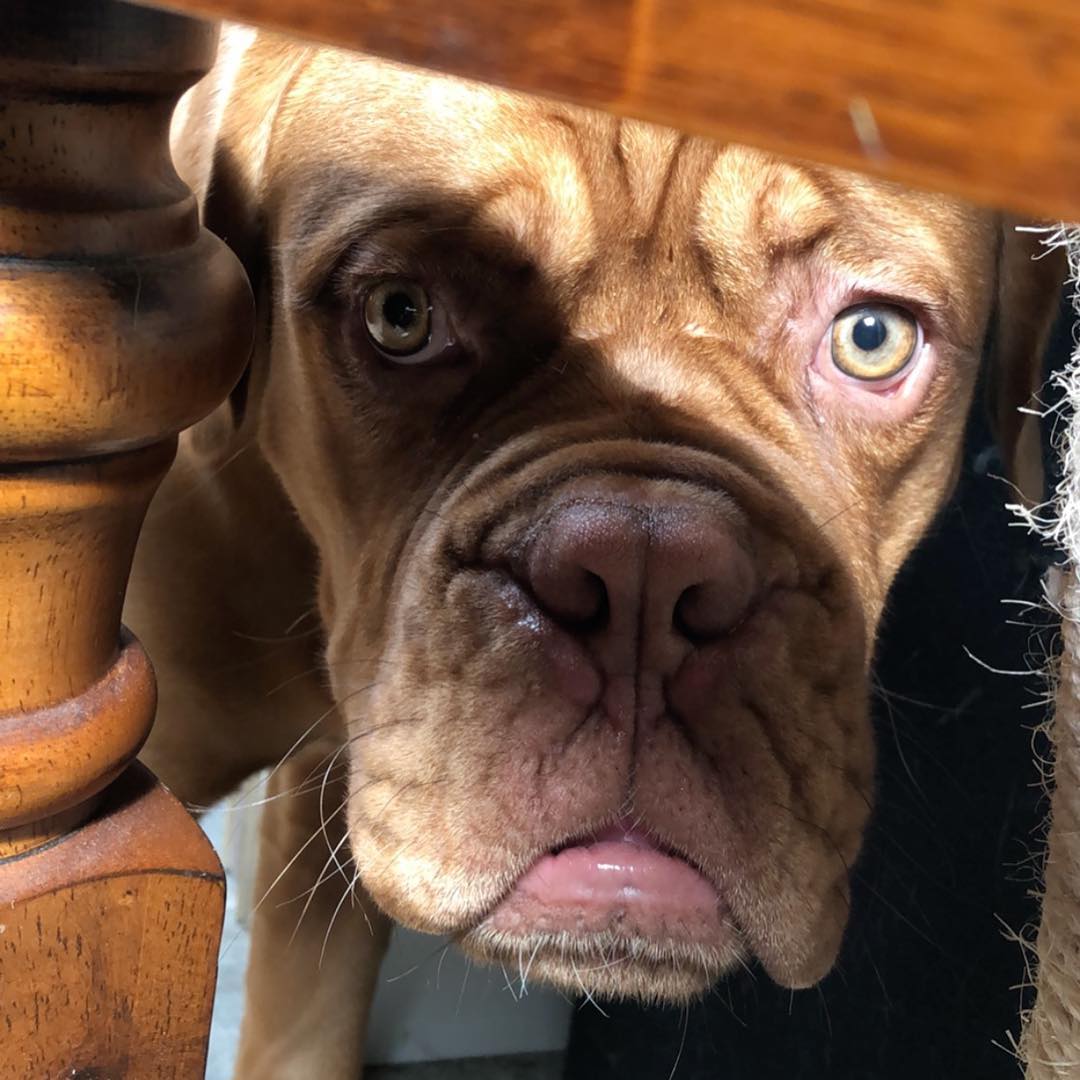
The origin of the Dogue de Bordeaux is considered a bone of contention for dog handlers all over the world: it is not known for certain who became the progenitor of the breed, and the controversy is still ongoing. Three theories are common among dog breeders. According to the first version, Great Danes descended from the fighting “French”, participants in bloodred dog pits. Adherents of the second theory believe that the breed originated from the bulldogs. The third version says that the genotype of the dogs is directly related to the Tibetan Mastiffs.
The first theory became the most widespread: “Bordeaux” inherited their appearance from the ancient Alans, widespread among the Spaniards and the French. These fighting dogs were described in detail by Gaston de Foix, who was fond of hunting and in the XIV century published a whole book, where the Alan appears to be one of the oldest hunting breeds in France. The grip of a powerful dog was proportional to the grip of three greyhounds at the same time, so the Alans were bred to hunt wild boars and other large prey. At the same time, the animals were also suitable for guarding cattle, transporting refreshed carcasses, and even for participating in widespread bloodthirsty entertainment – dog pits.
All Great Danes of France were divided into three types. The differences between them were dramatic. There were dogs with a uniform color or points over the entire surface of the body, a small or large head, a straight or scissor bite … They contributed to the appearance of the modern breed.
For a long time, the Dogue de Bordeaux was known as the French Mastiffs. Everything changed in 1863. The animals were presented under the current name. The victory was won by a dog named Magent, and this was the first step towards the official recognition of the breed.
Encouraged by the success, the breeders set about active breeding of dogs, which at least remotely resembled Great Danes. Everyone confidently asserted that it was in his nursery that purebred animals could be found. Despite the obvious similarity of “Bordeaux” with bullmastiffs, the fact of their relationship was denied. At the same time, most dog breeders argued the opposite: the British used the Dogue de Bordeaux to breed similar animals.
Purebred dogs have survived, albeit in negligible quantities. Breeder Euler managed to acquire a pair of representatives of the breed – a Buffalo dog and a Sultana female Since 1892, active work began on breeding purebred “Bordeaux”.
Four years later, veterinarian Pierre Ménien, who led a group of breeders, presented the first breed standard, copied from the aforementioned Buffalo. While other breeders considered it necessary to recognize dogs exclusively with a dark “mask”, Menyen did not support this hypothesis. The veterinarian’s explanation was simple: such marks are a sign of issue, so it is worth selecting dogs with a uniform color or with a brownish “mask”. Later, Menyen encouraged the breeding of exclusively red Dogue de Bordeaux with uncropped ears.
In 1910, a certain Mr. Kunstler joined the activities of Pierre Ménien. As a professional dog handler and a passionate dog lover, the man wrote a voluminous article about the Dogue de Bordeaux, using reliable documents and facts. Kunstler’s portrait of the animal was an extended breed standard. Like Mayenne, the dog handler believed that the presence of a black “mask” on the face of a “Bordeaux” is unacceptable since such a dog is not considered purebred.
The first breed club was founded in 1924 under the leadership of A. Bare. On his shoulders fell the responsibility for restoring the breed after the events of the First World War. Two years later, based on an article by Kunstler, Bare created a new standard.
The breed nearly found itself on the brink of extinction after 1939-1945, when the number of dogs dropped dramatically. Since the Dogue de Bordeaux was quite large animals, feeding them in wartime turned out to be an almost impossible task. Many dogs were killed or euthanized so as not to burden themselves with an additional “burden” in the person of a hungry pet. Few breeders selflessly protected their wards. In the history of the Dogue de Bordeaux, the name of only one has survived – Mr. Van Capel, who did not leave the dogs to their fate.
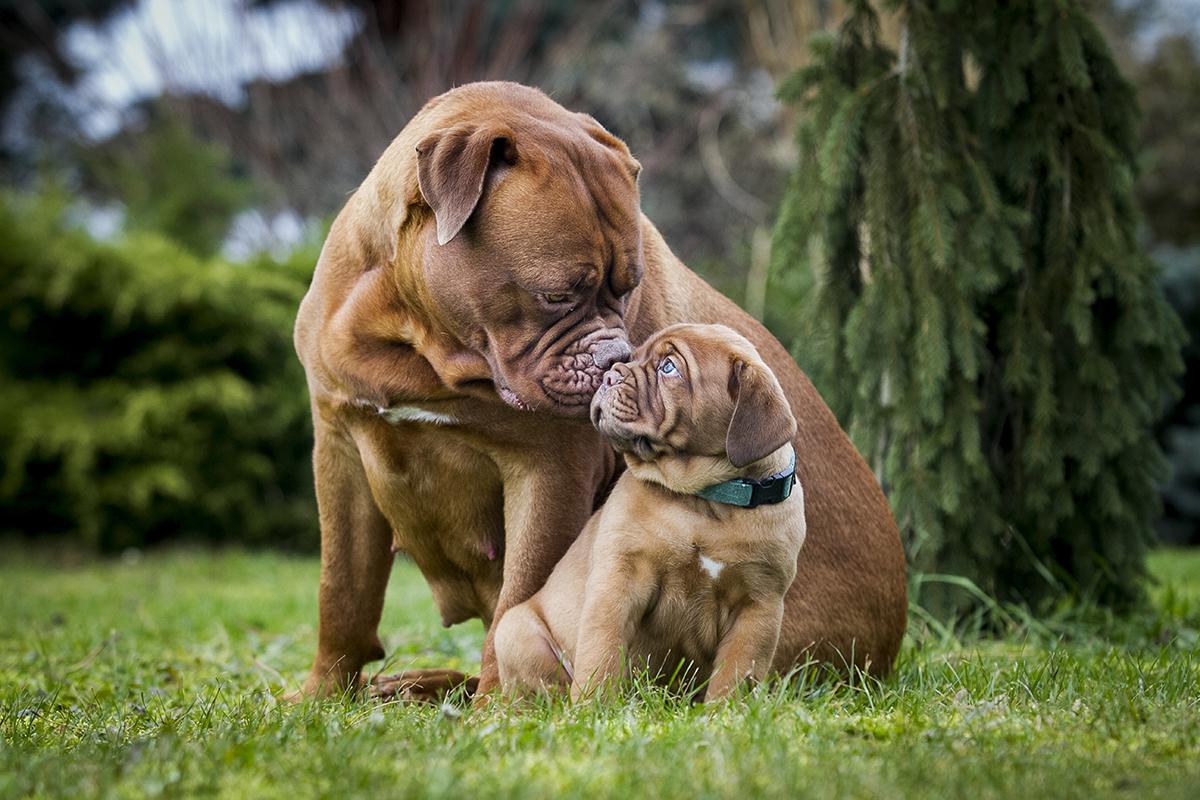
Purebred dogs have survived, albeit in negligible quantities. Breeder Euler managed to acquire a pair of representatives of the breed – a Buffalo dog and a Sultana female Since 1892, active work began on breeding purebred “Bordeaux”.
Four years later, veterinarian Pierre Ménien, who led a group of breeders, presented the first breed standard, copied from the aforementioned Buffalo. While other breeders considered it necessary to recognize dogs exclusively with a dark “mask”, Menyen did not support this hypothesis. The veterinarian’s explanation was simple: such marks are a sign of issue, so it is worth selecting dogs with a uniform color or with a brownish “mask”. Later, Menyen encouraged the breeding of exclusively red Dogue de Bordeaux with uncropped ears.
In 1910, a certain Mr. Kunstler joined the activities of Pierre Ménien. As a professional dog handler and a passionate dog lover, the man wrote a voluminous article about the Dogue de Bordeaux, using reliable documents and facts. Kunstler’s portrait of the animal was an extended breed standard. Like Mayenne, the dog handler believed that the presence of a black “mask” on the face of a “Bordeaux” is unacceptable since such a dog is not considered purebred.
The first breed club was founded in 1924 under the leadership of A. Bare. On his shoulders fell the responsibility for restoring the breed after the events of the First World War. Two years later, based on an article by Kunstler, Bare created a new standard.
The breed nearly found itself on the brink of extinction after 1939-1945, when the number of dogs dropped dramatically. Since the Dogue de Bordeaux was quite large animals, feeding them in wartime turned out to be an almost impossible task. Many dogs were killed or euthanized so as not to burden themselves with an additional “burden” in the person of a hungry pet. Few breeders selflessly protected their wards. In the history of the Dogue de Bordeaux, the name of only one has survived – Mr. Van Capel, who did not leave the dogs to their fate.
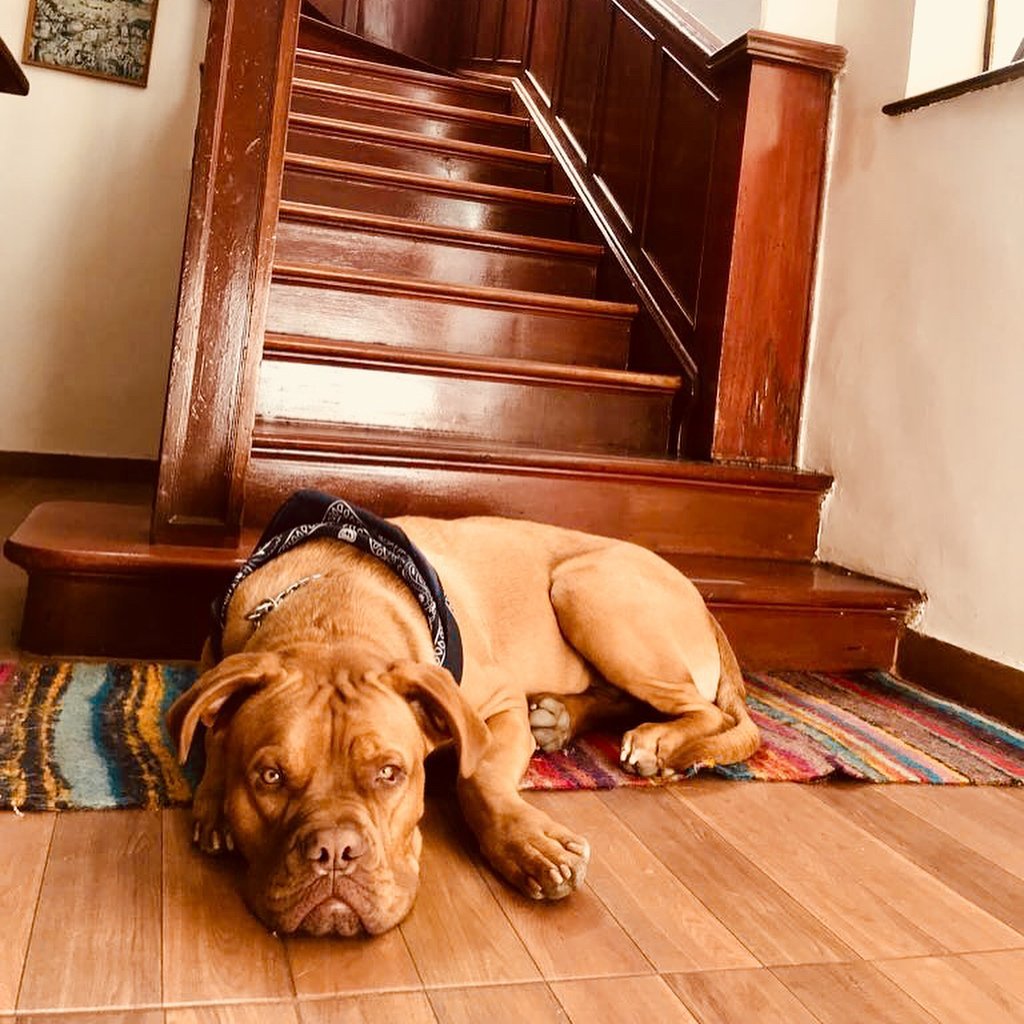
Nature has generously endowed the Dogue de Bordeaux with an athletic physique, good health, and remarkable strength. Despite some squatness, “Bordeaux” look harmonious, and the extravagant charm of animals smoothes out their external roughness.
The standard provides for the specified height and weight of the Dogue de Bordeaux. The height of males at the withers reaches 60-68 cm, their body weight is 50 kg and more. Females have other parameters: height is about 58-66 cm and weight is in the range of 45-50 kg. Gender dimorphism is pronounced. Males are massive and heavy, and their character is more restless.
When viewed from above, the trapezoidal shape of the head is noticeable; when looking at the animal from the front, it is square. The convex forehead is divided by a shallow depression in the center. From it folds diverge, which deepen when the Dogue de Bordeaux is excited. The brow ridges and cheekbones of the dog give the skull a noticeable volume.
The muzzle of the “Bordeaux” is slightly shorter than the forehead. Its distinctive feature is a “mask” one tone darker than the main color of the coat. The stop is pronounced, almost at a right angle. The wide lobe is turned up, but not flattened. Lips are fleshy, forming an inverted “tick”. The chin is massive.
The small ears of the Dogue de Bordeaux are rounded, barely reaching with their tips to the outer edge of the eyes. Their high and wide (in comparison with each other) landing visually makes the dog’s skull more massive. The ears rise when the animal is excited and fit tightly to the cheekbones if the Great Dane is alert.
The eyes are set rather low. The color of the iris can be different: hazel or brown – in dogs with a dark “mask” on the muzzle, light brown – in animals with a red “mask”. The latter option is also typical for dogs with a complete absence of a “mask”.
The lower jaw of the Dogue de Bordeaux protrudes forward and slightly rises above the upper one. The incisors of the dog are set in line. The breed is characterized by undershot (bulldog bite).
The neck of the Dogue de Bordeaux has a cylindrical shape. The nape is convex, connected to the wide withers of the animal. The appearance of the dewlap and dewlap is created by folds of skin on the dog’s throat.
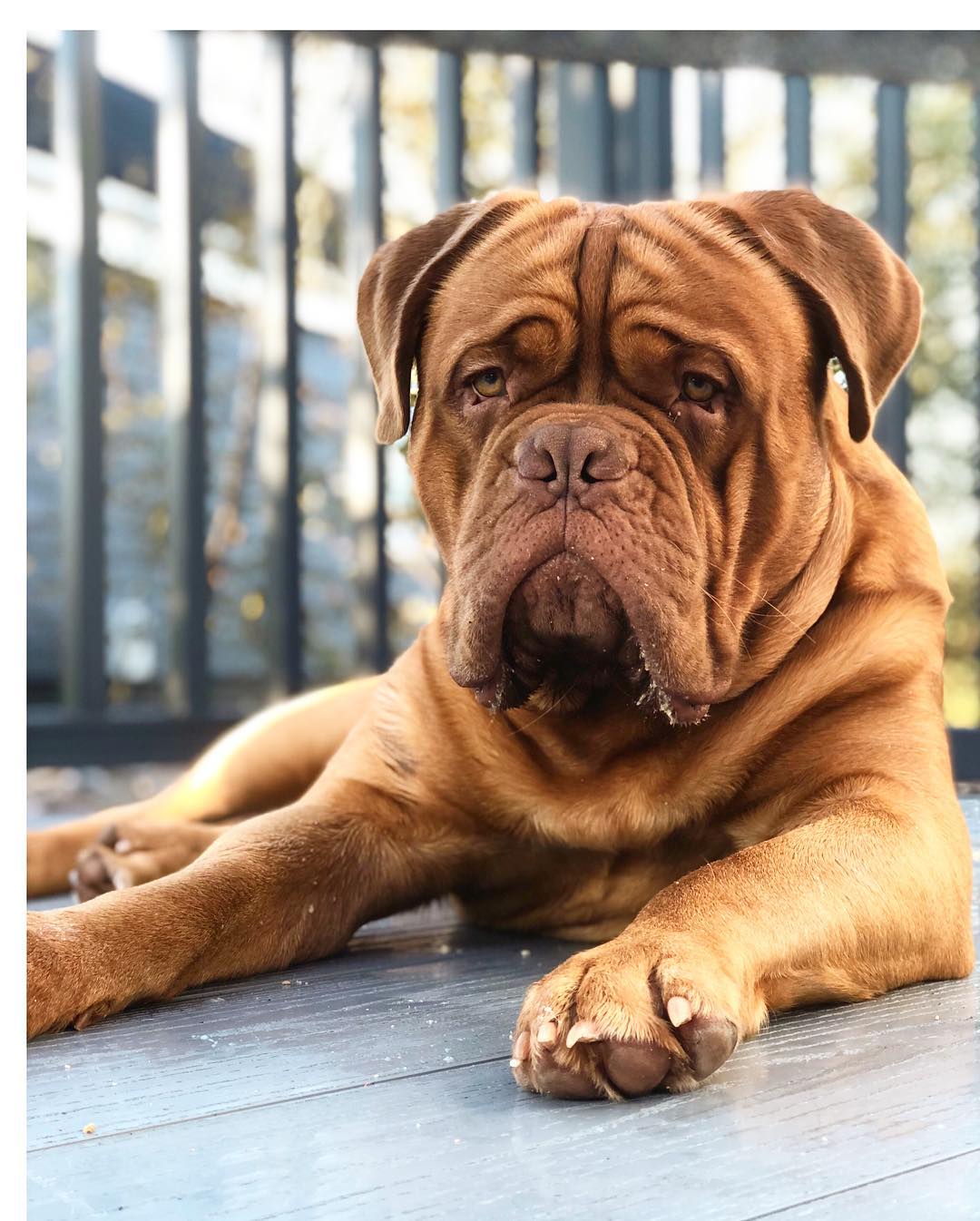
The body of the “Bordeaux” is elongated and has a massive bone structure. The withers are raised. The shoulder blades are tightly pressed. The back passes into a rather convex loin, and that into an oblique croup of the Great Dane. The ribcage is well filled. Rounded ribs are slightly flattened on both sides. The lower part of the chest passes into a tightened bottom line.
The tail has a broad base and moderate length. Its tip is lowered to the hocks of the animal. In a calm state, the tail falls, and in motion, it rises by 100 °.
The forelimbs are particularly massive in the area of the shoulders, which form a right angle with the shoulder blades. Elbows are tight. The forearms and pasterns are vertical. Paws are strong, “equipped” with crowded toes with strong claws. Elastic pads.
The hind legs are set at a smaller distance from each other in comparison with the front legs. On the wide hips of the dog, well-developed musculature is noticeable. The joints are accentuated, the metatarsus is vertical. The paws are slightly longer than the front ones; dewclaws are absent. Strong nails.
Dogue de Bordeaux prefers to trot, but with an increase in speed, they begin to “creep” along the ground. The unhurried step of the dog is characterized by amble. In other cases, the movements are sweeping and elastic.
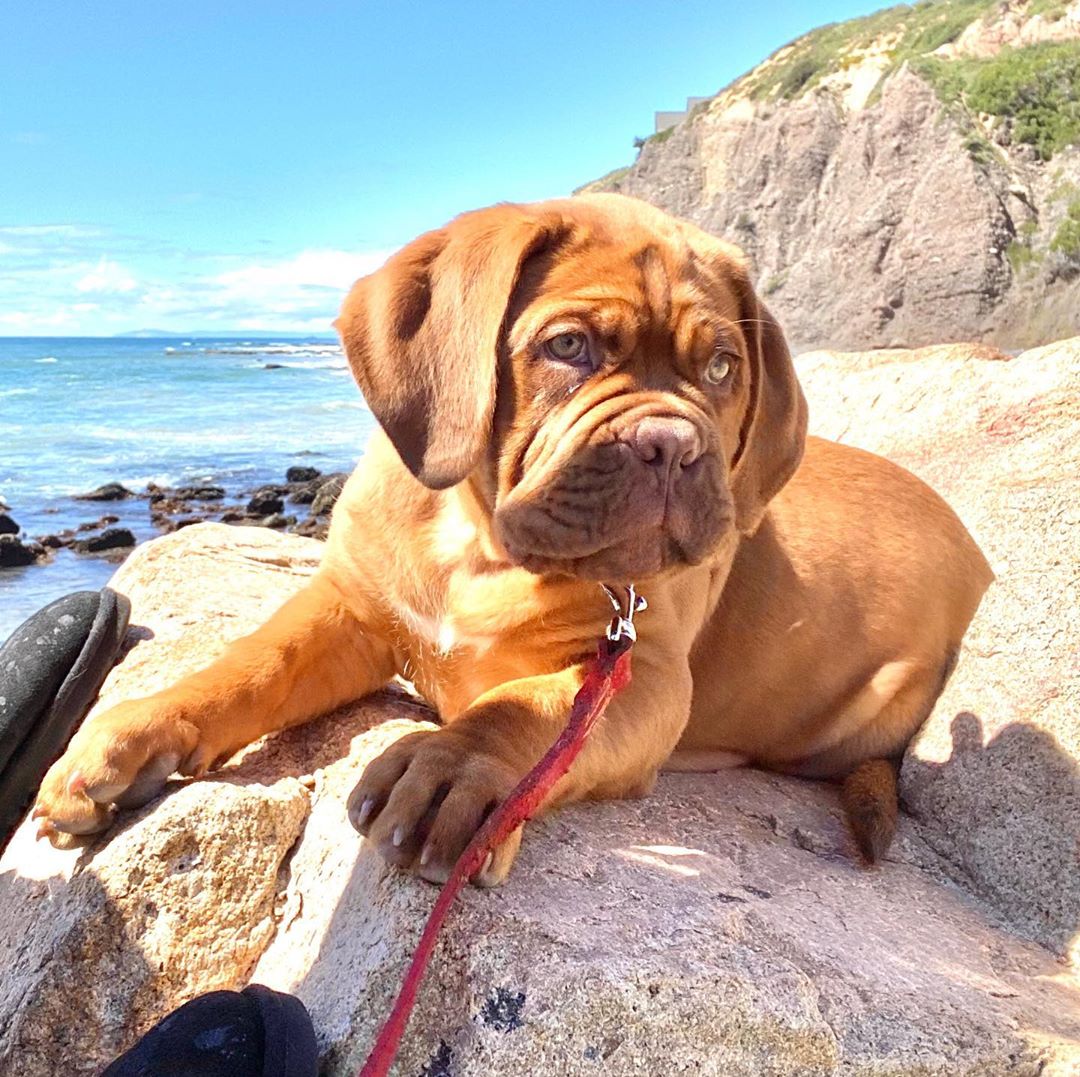
The coat of the Dogue de Bordeaux is short and thin, rather soft, tightly fitting the body of the dog. There is no undercoat.
The breed standard allows dark and light shades of brown. White points on the chest and fingertips are acceptable. The “mask” is one tone darker, maybe black or absent. For the latter case, the reddish or pink color of the nose is characteristic.
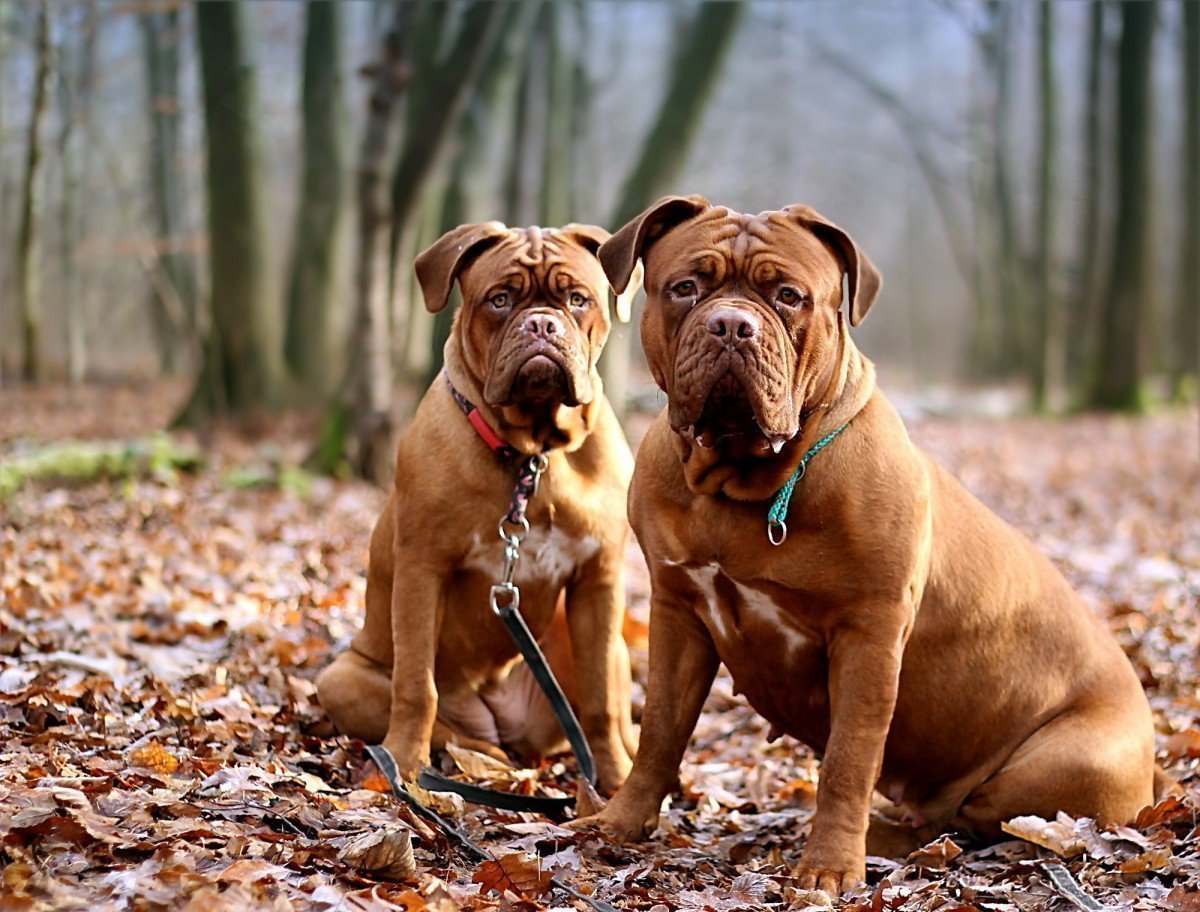
Any (even the slightest) deviation from the Dogue de Bordeaux standard is considered a breed defect. The most common are:
- close bulldog, scissor, or straight bite;
- swinging the croup in a vertical plane when moving;
- weak and rather stretched back and/or lower back;
- a tucked or straight belly line;
- unexpressed musculature of the limbs;
- close-set and / or around eyes;
- shyness and melancholy;
- heavy movements;
- loose physique;
- undeveloped jaws;
- hyperexcitability;
- elongated neck;
- small teeth.
Disqualifying vices of the Dogue de Bordeaux include:
- Humpback / sagging back and/or lower back;
- domed or bulldog head;
- barrel-shaped or dreamy chest;
- white points on the head and body of the dog;
- aggressive or cowardly behavior;
- square or elongated body;
- large or small eye slit;
- atypical pigmentation of the iris;
- low or high neck;
- excessive thinness or obesity;
- snoring when the animal moves;
- shortened upper lip;
- “Femininity” of males;
- very short tail;
- undescended egg-shaped glands
- straight canines.
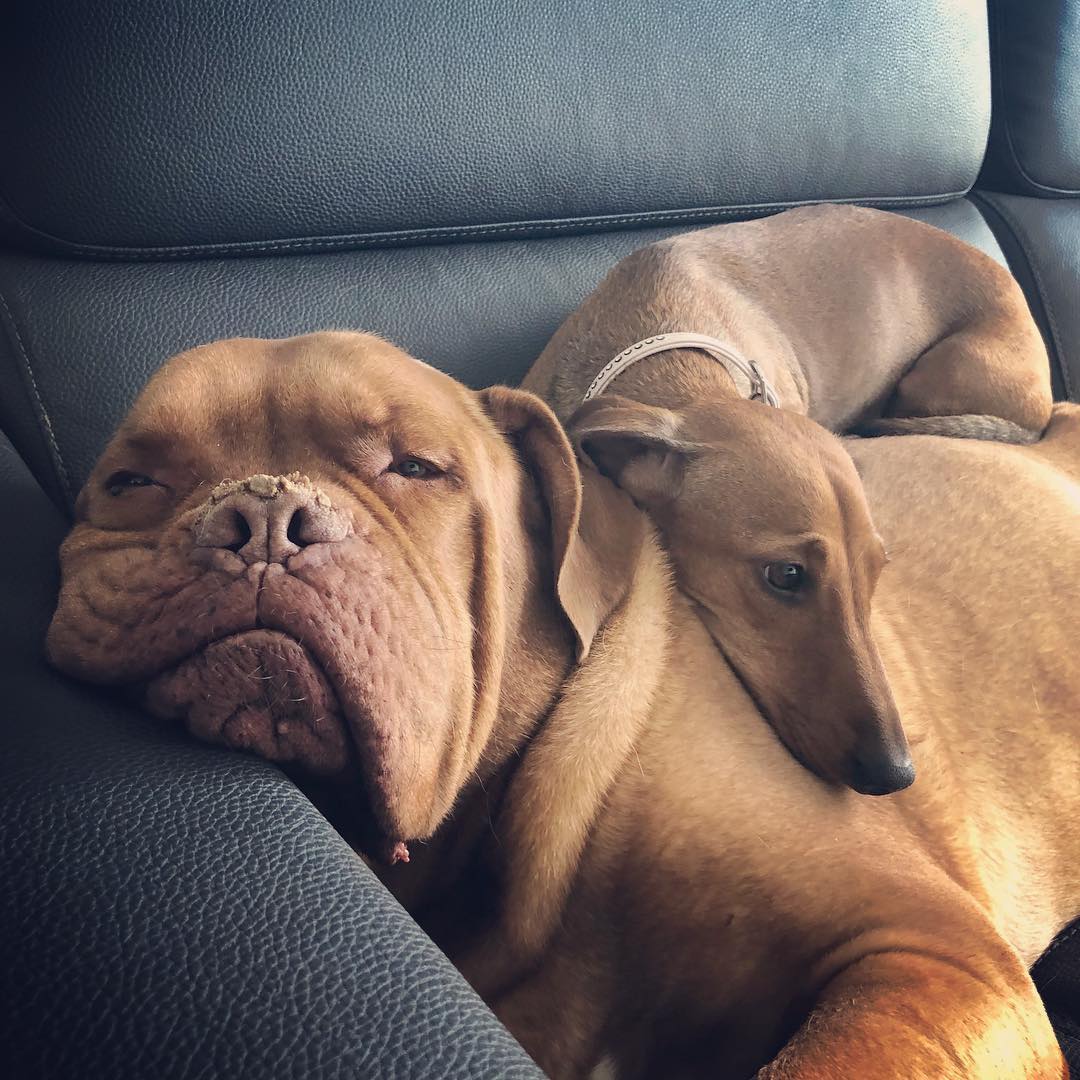
The frightening appearance of the Dogue de Bordeaux is the main reason why people consider these dogs to be aggressive and dangerous. It is worth discarding stereotypes – and the dog will appear before you different: playful, loyal, and loving. For an animal, there is no punishment worse than loneliness. Lack of attention negatively affects the behavior of Bordeaux, so do not be surprised if you return home with damaged furniture, broken vases, and an overturned bucket of water.
Representatives of the breed are completely devoted to the family in which they live, and especially to their owner. Sitting down at the desk or sitting comfortably on the sofa, do not be too lazy to lower your hand down: after a few minutes, your pet’s wet nose will definitely burrow into it. As soon as you decide to leave the room, the dog will immediately follow, no matter how sound and comfortable his sleep was.
Dogue de Bordeaux behaves similarly on the street. Walking without a leash, the animal prefers not to move far from the owner, so as not to lose sight of him. So that your pet can stretch its paws, arrange an easy jog in the city park. This will not only cheer up the dog, but also provide you with a little peace of mind in the evening: a tired dog will take a place on his favorite bedding, and will not arrange a route to throw out the accumulated energy.
“Bordeaux” cannot be called a family dog, but it gets along easily with children over six years old. The fuss and noise of a younger child are perceived by the dog as a potential threat. In addition, the huge dimensions of the animal make it quite traumatic: passing by, the Dogue de Bordeaux can inadvertently push your child or fall on him during the game. Cynologists recommend postponing the purchase of a dog until the children go to school, but even in this case, it is necessary to closely monitor the relationship that develops between the child and the “Bordeaux”. The slightest conflict should be nipped in the bud.
The cohabitation of the Great Dane with other pets is possible under certain conditions. A properly trained dog will not bare its teeth at its relative, but the same cannot be said about males, which most often have a competitive relationship with animals of the same gender Dogue de Bordeaux gets along quite easily with a domestic cat, but at the sight of a stranger, it will certainly rush in pursuit and, most likely, will delight “prey”. On a walk, it is not recommended to let the dog off the leash, if you do not want to become an accomplice in the bloodred massacre. Representatives of this breed have an excessively heightened hunting instinct, so you should not risk it, even if you are sure of the calmness of the pet.
The socialized Dogue de Bordeaux will not rush to attack a stranger. The main thing is to treat the giant with respect and not bother him with undue attention. Listen to your dog’s grumbling: this is often a warning signal and may be followed by an attack.
The breed makes excellent guards. “Bordeaux” will not be allowed to enter the territory entrusted to them without a demand. Even when a stranger appears, the Great Dane will not immediately rush in pursuit. First, the animal will try to properly scare the unwanted guest with a formidable appearance, and only then will it show strength. If it comes to protecting the family, the Dogue de Bordeaux will fight to the last and most likely will be the winner.
An interesting feature of the character of the dog is considered its intolerance to the smell of alcohol. Refrain from walking with the Dogue de Bordeaux during city festivities: meeting a drunk person can cause your pet to become irritable. Under certain circumstances, the Great Dane attacks, and it is rather difficult to restrain a dog of this size – even if it is on a leash.
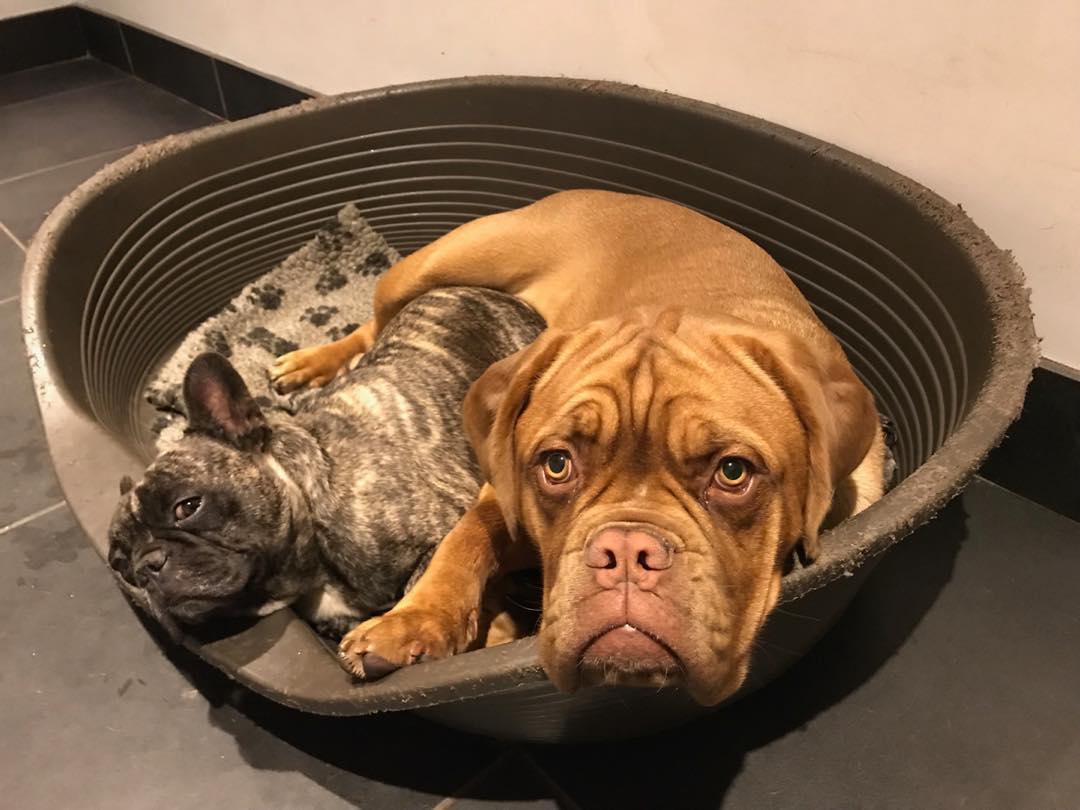
Dogue de Bordeaux is distinguished by their quick-wittedness and developed intellect, but this by no means facilitates the process of education and training. Starting from puppyhood, it is necessary to teach your pet to treat people with trust. Pick up your baby regularly and gently stroke his soft fur. In the minds of Bordeaux, a person will be associated with positive emotions. However, you should not trust the manifestation of affection to strangers who do not know how to handle dogs.
Many owners of Dogue de Bordeaux note that puppies are most obedient at the age of three weeks. It is at this time that it is necessary to begin active upbringing and accustoming the baby to the rules of behavior. It is not recommended to stop exercising for an extended period. Learned tends to be forgotten, especially as the “Bordeaux” matures and new distractions appear.
From the very beginning, the dog must learn a simple truth: there is only one leader in the “pack”, and this is not him. If you show gentleness of character, a matured dog will create a lot of trouble. Representatives of the breed are quite capricious and know how to find weak points in the “armor” of the owner. In addition, the Dogue de Bordeaux are excellent manipulators, so they may soon begin to train you.
Teach your pet to jump with its paws on the chest. You are unlikely to be happy when a 50 kg dog does it, and not an adorable puppy. Excessive obsession is another character trait of the Dogue de Bordeaux that should be eradicated. Remember: the slightest indulgence from one of the family members will nullify your attempts to raise a decent dog from a pet.
Representatives of the breed quickly learn what is required of them. Your job is to reward your pet at the right time. Do not force the Dogue de Bordeaux: it will not help. It is much more effective to make the dog want to fulfill your request. There are many ways: a treat, an extraordinary walk in the park, or a pet’s favorite toy.
The training of the Dogue de Bordeaux is rather difficult. Along with an inquiring mind, dogs are distinguished by independence and stubbornness, so learning a new team can take more than one day. The workout should be consistent and short (no more than an hour). Do not raise your voice at your pet and reward his success with an affectionate stroke or treat. Harsh shouts and rude orders are your main enemy: the distressed animal is lost and trains even worse. If the Dogue de Bordeaux indulges, limit yourself to a severe reprimand, and then immediately cheer up the dog by suggesting to repeat the command.
Dog breeders note that representatives of this breed are quite often lazy and become slow. Don’t scold your dog for taking too long to think about commands. It is worth winning the respect and love of a four-legged friend, and the training process will go like a knurled path!
An important point in learning the Dogue de Bordeaux is walking on a leash. Don’t let the puppy drag you forward! As they grow older, it will be more difficult to keep the animal. If the pet breaks off the leash, pull it, otherwise, you will switch roles during the walk.
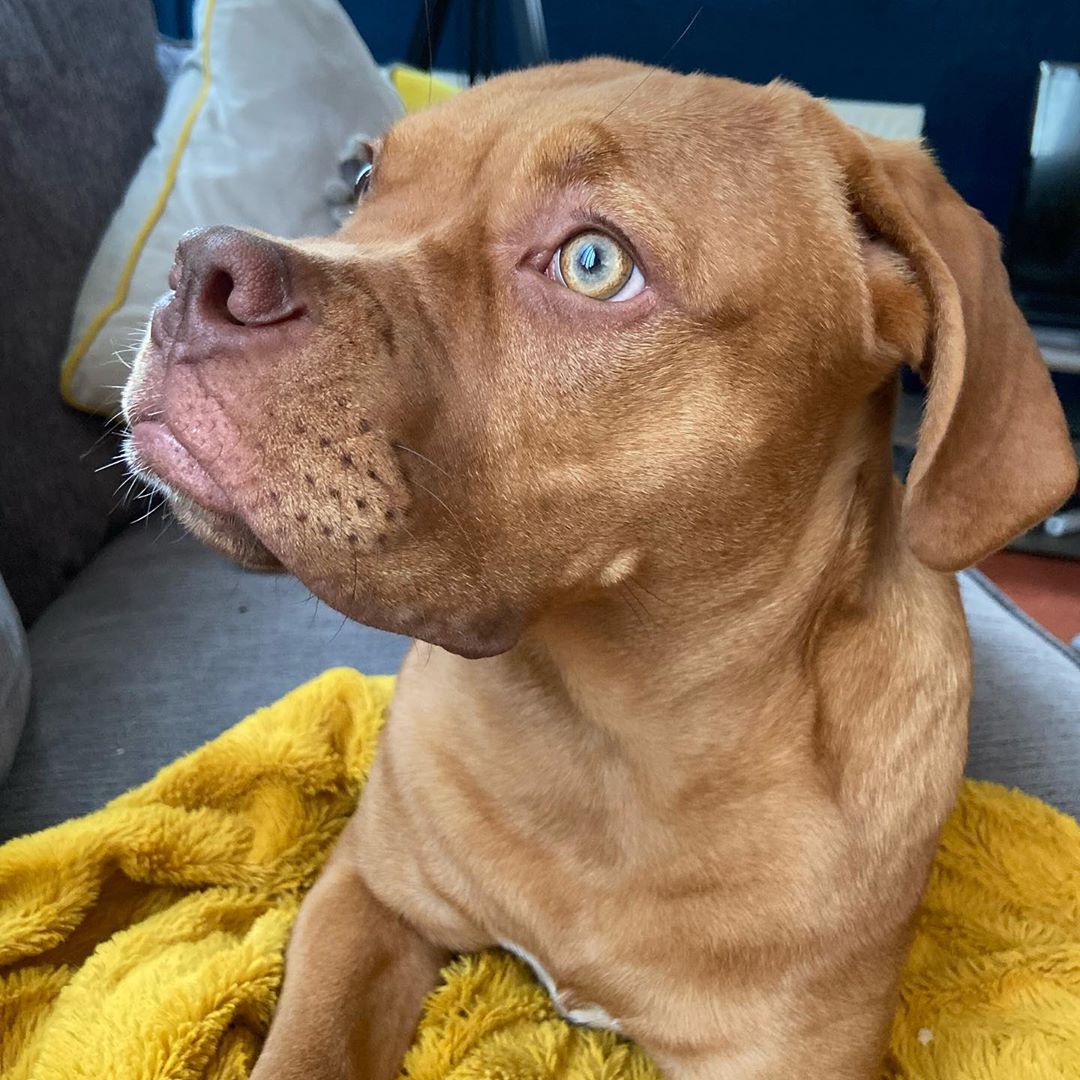
Short-haired dog breeds do not require painstaking care, and the Dogue de Bordeaux is no exception. The only thing you have to tinker with is water procedures. These dogs love to wallow in the mud, so be prepared to bring home not a pet, but a huge and seemingly unfamiliar muddy. Dogue de Bordeaux is bathed as needed or twice a month. For washing, use a pet shampoo or its dry analog (the latter is becoming more and more popular among dog breeders).
In addition to bathing, you will have to wipe the Great Dane’s face daily, and especially its folds. Saliva and food often accumulate in them, since the animal eats extremely carelessly. Arm yourself with a damp piece of cloth and carefully remove any excess from the folds on the face. This will help prevent unpleasant odors.
Caring for the coat of the Dogue de Bordeaux is effortless. It is enough to wipe it with a woolen cloth two or three times a week (to give a healthy shine). During seasonal molting, which is almost imperceptible, use a special mitt with silicone “growths”. They will delicately remove dead hairs from your pet’s fur.
The ears of the Dogue de Bordeaux tend to accumulate dust and dirt, thereby creating a breeding ground for bacteria. Your task is to prevent possible inflammation. Lift your ear and wipe it with a moistened cotton pad. Use a cotton swab to remove the wax, but be careful: careless movement can damage the eardrums of the animal! If you don’t want to risk it, wrap your finger with gauze and do the same. The result will not be as effective, but safe.
Remember: an unpleasant smell, redness, or a huge accumulation of sulfur is an alarming sign and a reason to go to a veterinary clinic.
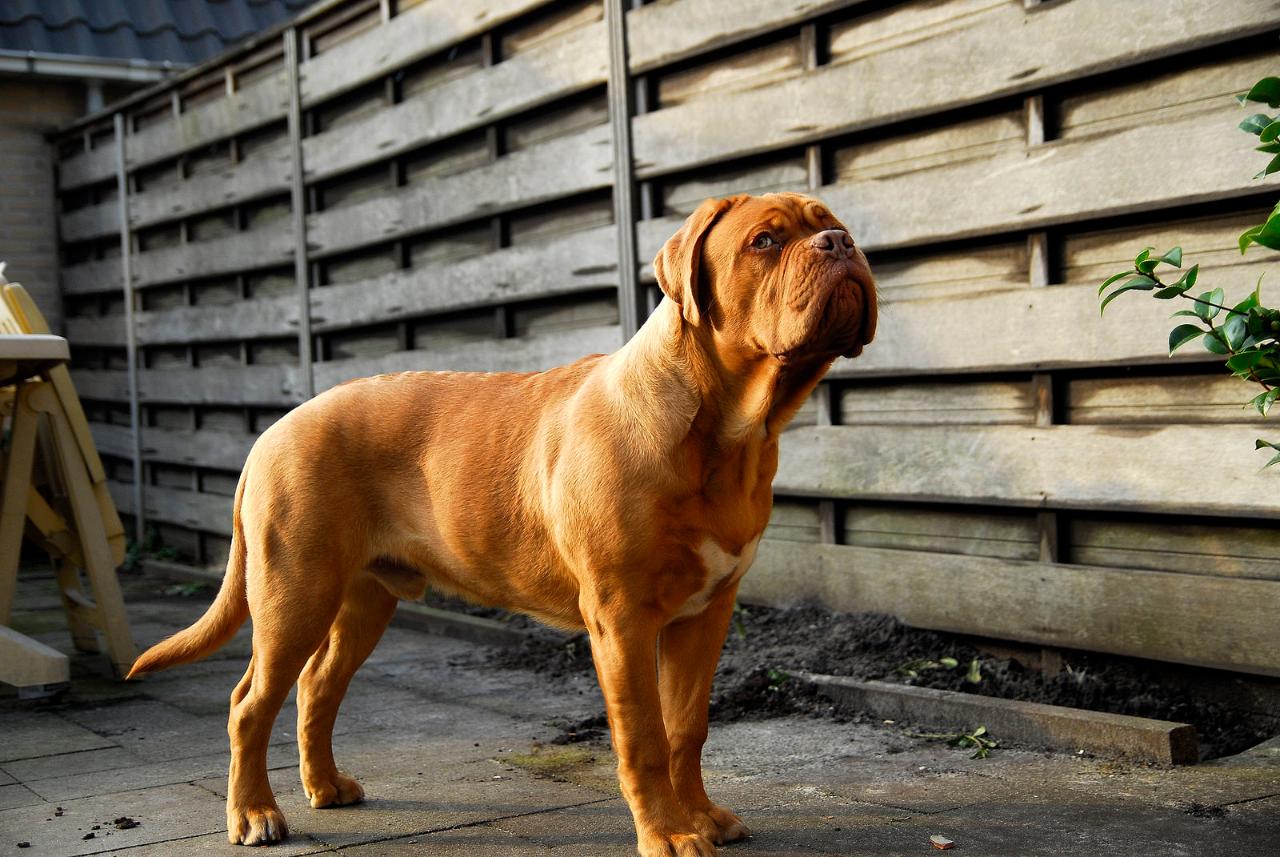
Remember to check and rub your pet’s eyes. For this procedure, use a cotton pad moistened with weakly brewed tea or warm boiled water. If a heavy discharge in the corner of your eyes is unhealthy, make an appointment with your veterinarian. Your inaction in the future will create a host of health problems for your dog.
The oral cavity of the Dogue de Bordeaux needs no less care. Brush your pet’s teeth three times a week with dog paste and an old brush. You can use a more budgetary option: wrap your finger in cheesecloth and walk it over the teeth of “Bordeaux”. If your pet is acting restlessly, calm him down with gentle stroking and a promise to give a treat after the end of the “execution”.
The claws are shortened twice a month using a claw cutter. Use a nail file to remove sharp edges and burrs. Do not forget to wipe your paws thoroughly after a walk. If cracks or wounds appear, lubricate the pads with a greasy baby cream or antiseptic. It will not be superfluous to include sunflower oil in the diet of Dogue de Bordeaux (no more than one teaspoon per day).
Important: treatment of wool with a parasite agent and deworming should be carried out regularly – once and four times a month, respectively.
Dogue de Bordeaux does not tend to be overweight with a balanced and properly selected diet. The more monotonous and “lighter” the food, the smoother the dog’s digestion. With a natural diet, meat should be the basis of your daily diet. It must be alternated with offal, sea fish, and fermented milk products. From time to time you can treat your pet to fruits and vegetables, and in winter – compensate for their lack with a complex of vitamins and minerals.
When using commercial food, purchase premium products while making sure to focus on options for large dog breeds. A visit to the veterinarian will not be superfluous: he will tell you which food is better to pay attention to.
The dog’s bowl should always contain freshwater – bottled or from the tap, previously infused for 6-8 hours.
Representatives of the breed need daily hour-long walks, especially in urban environments. In the hot season, give preference to morning and evening promenades: the high temperature causes hoarse breathing and shortness of breath in Bordeaux. You can take a bottle of water with you and give your dog a cool shower for a few minutes when you return home.
If possible, go with your four-legged friend to nature so that he can run around to his heart’s content. Take your favorite ball and treat with you: rehearsing the commands you have learned in the fresh air is a great alternative to the usual training at home.
Dogue de Bordeaux is difficult to keep in an apartment. You will have to provide comfortable conditions, including active walks so that the animal feels at ease and does not seek to release the accumulated energy to the detriment of your interior.
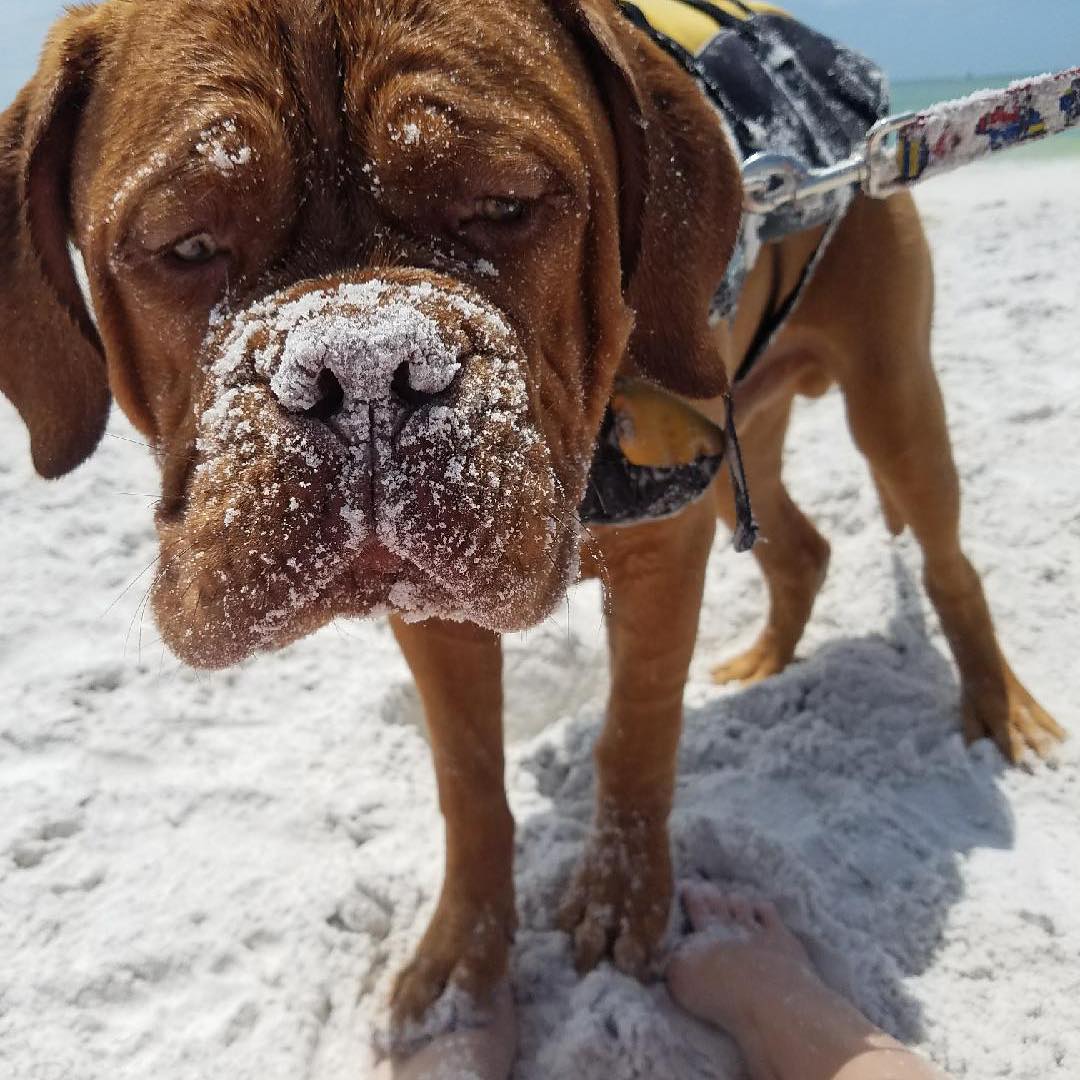
“Bordeaux” is distinguished by good health and is practically not susceptible to common diseases. At the same time, do not forget that adult dogs can boast stable immunity. Unvaccinated puppies are a vulnerable target. It is not recommended to walk your baby outside until you have all the necessary vaccinations.
Dogs often have difficult labor. Do not leave your pet and be ready to help him as much as possible.
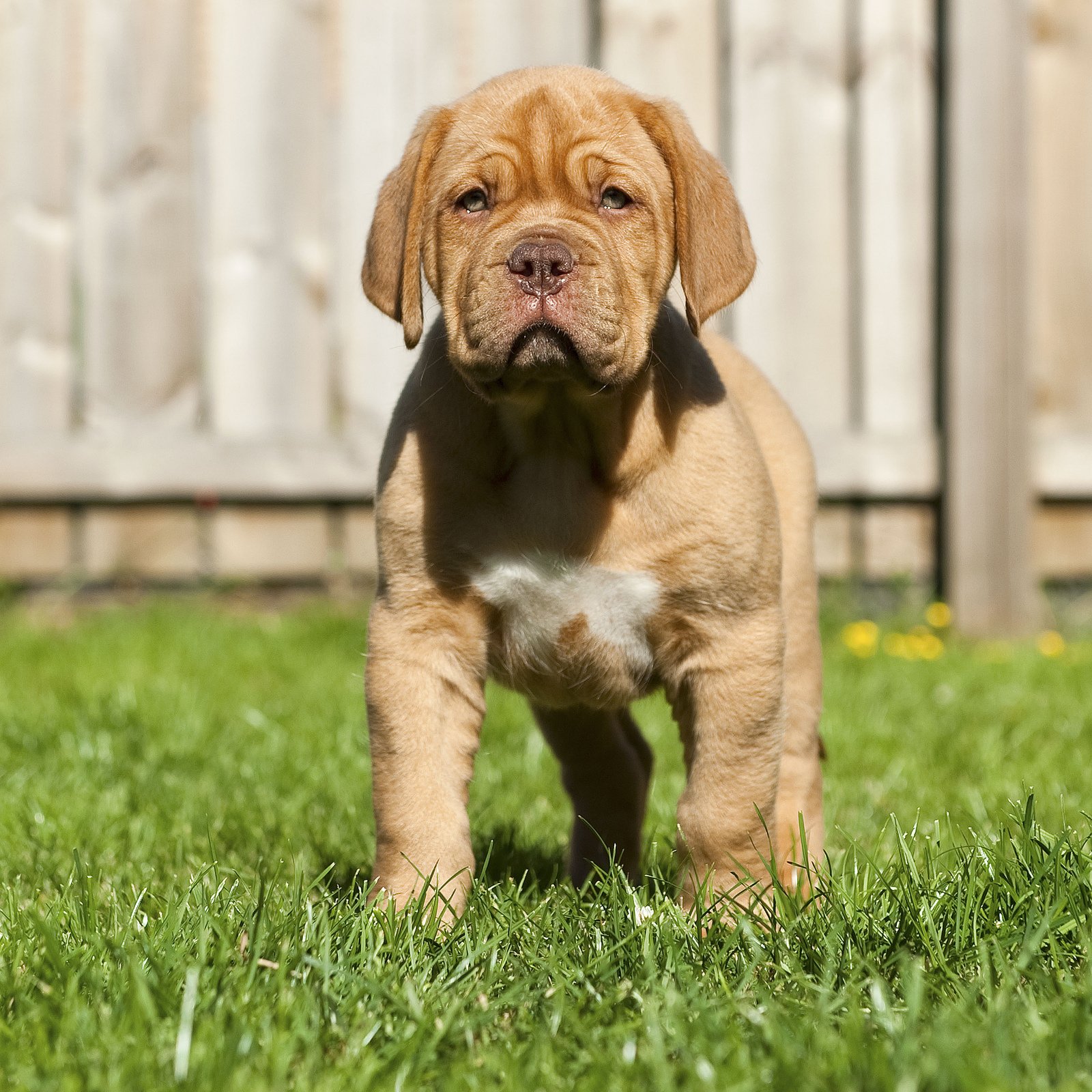
How to choose a puppy?
When planning to get an adorable four-legged friend, decide on his class. Dogs of the “show” category can win at the show since they correspond to the breed standard as much as possible. For animals of the breed class, slight deviations are allowed, but this does not prevent the use of dogs for breeding. Dogue de Bordeaux of the pet class is typical pets, whose non-conformity to the standard does not allow participating in exhibitions or breeding programs.
The next step is the gender of the animal. Females are more obedient, but cunning and female slyness they do not hold. Males are quarrelsome and independent, so you have to show remarkable strength of character in dealing with them.
Now you can start looking for a proven nursery. Before meeting the babies, ask the breeder to introduce you to their parents. Pay attention to possible defects: they can be inherited by puppies. It is equally important to check the necessary documentation: veterinary passport, pedigree diploma, dysplasia test results. Only after that can you go to a meeting with your future friend.
A healthy puppy is moderately playful and curious. The animal should not limp, whine for no reason, hide cowardly, show lethargy or excessive excitement. Examine the baby carefully and finally check the brand and nickname with his passport. Now you can start making a deal with the breeder.

